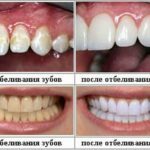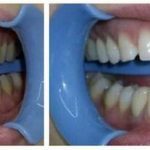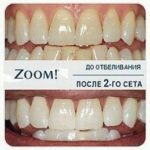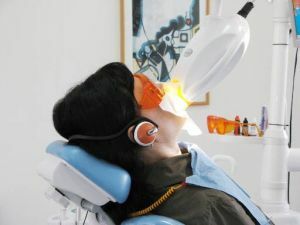 Photobleaching is a modern technique for professional clarification of enamel, which is carried out with the help of special solutions and gels activated by a special ultraviolet, LED, halogen or laser lamp.
Photobleaching is a modern technique for professional clarification of enamel, which is carried out with the help of special solutions and gels activated by a special ultraviolet, LED, halogen or laser lamp.
This technique allows for clarification of enamel up to 12 tones per visit. Depending on the structure of the teeth, patients can clarify the enamel in one visit, or take a more gentle course of three procedures. Lightening with ultraviolet usually gives a noticeable result.
The principle of teeth whitening with the use of special lamps is simple - a special solution is used, the activity of which is increased by exposing it to an ultraviolet or other type of radiation with a wavelength of about 450 nm.
The gel contains hydrogen peroxide, or its derivatives, active oxidants. These substances penetrate the surface layer of the enamel, and then disintegrate there under the influence of lamps on water( or other neutral substance) and atomic oxygen, which reacts with the pigment, oxidizing and brightening it.
Contents of
- Advantages and disadvantages of
- technique What kind of lamps are used?
- How's it going?
- Which method to choose: review of results and reviews
- Not suitable for all
- Consequences and complications
- Cost of
Advantages and disadvantages of
technique Photobleaching has a number of advantages in relation to other methods for professional clarification:
- Safety .Since the procedure is performed by qualified specialists and special protective equipment is used for it( napkins, liquid cofferdam), the risk of complications in the form of mucosal necrosis is zero. Also, the use of special light-activated compounds has a less aggressive effect on enamel than chemical brightening. Prevention of complications .Almost always after the procedure of photobleaching doctors apply to the surface of the enamel special varnishes containing sodium fluoride. These funds saturate the tissue with fluoride and do not allow minerals to wash out of it, which serves as a preventive measure of hyperesthesia and carious process.
- Fast and significant result of .Teeth whitening with a special gel and lamp allows to brighten the enamel by 12 tones, and the longest course is three sessions.
- Improving the state of oral hygiene .Professional cleaning of tartar is an obligatory stage of preparation for the procedure. This not only aesthetically improves their appearance( teeth become 1-2 times lighter and look better in general), but also helps to reduce gum inflammation due to the disappearance of the traumatic agent, and also reduce the number of microorganisms in the oral cavity and create conditions that prevent the formation of newbacterial colonies.
But along with the advantages, this technique has some disadvantages:
- Relative cost of .For phototreatment, expensive equipment is needed, which makes this method more expensive than other methods of office lighting of enamel coating.
- Development of the Sensitive Sensitivity .In some patients, due to the weak mineralization of the enamel or its small thickness, bleaching leads to the development of hyperesthesia. However, this can be avoided if the doctor first covers the teeth with fluorolac, and also appoints pastes containing strontium( for sensitive enamel) for morning cleansing.
- Violation of the operating rules or the use of unsuitable lamps can lead to a burn of pulp and even pulpit .If the doctor uses a lamp that is able to heat the tissues heavily, this is fraught with the development of thermal pulpitis, since exposure under ultraviolet for bleaching is at least 15 minutes. To such a formidable complication, first of all, the use of lamps for curing fillings instead of special lamps for teeth whitening.
Which lamps are used?
Four kinds of lamps are used: 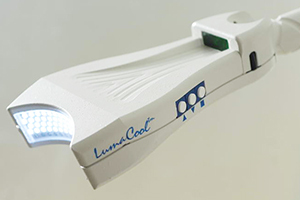
- LED - safe for use, since they do not heat the fabric;it is possible to clarify the enamel by 5-7 tones after 3 procedures for 8 minutes;an example of such a system is Luma Cool;
- laser uses radiation in the range 488-514 nm, they additionally increase enamel density up to 40% and allow it to lighten by 7-10 tones per visit( laser beams use Beyond bleaching system);
- halogen lamps in combination with LED lamps are used in the Beyond Polus system;
- ultraviolet - the most effective, but unsafe systems, in which tissue overheating is possible;in one session it is possible to clarify up to 10 tones, in particular, ultraviolet rays are used in the Zoom 3. Whitening system.
How does it happen?
The whitening technology depends on the peroxide gel used, as well as the type of lamp used. However, the preparation for tooth whitening always follows a single pattern:
- The doctor tells the patient about the cost of one or another type of bleaching, its effectiveness and possible consequences.
- The doctor interrogates the patient and conducts an examination, on the basis of which he determines the initial state of the enamel. At this stage it is possible to conduct a TER-test showing the degree of mineralization.
- Based on the findings, the doctor determines whether there are contraindications to teeth whitening, and which method will be most effective and safe. After this, the doctor gives the patient recommendations regarding the procedure and preparation for it.
- After the desired method is selected, the doctor tells about possible complications, dietary peculiarities and other precautionary measures after bleaching.
- Before the procedure begins, the doctor conducts the removal of stones. This is an obligatory stage of preparation, already after it, in some patients, clarification of enamel is observed on 1-2 tones.
The bleaching process itself depends on the light system used.
Beyond: 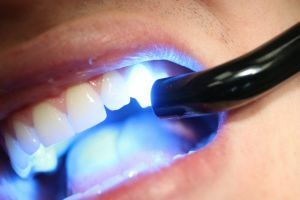
- technology puts eyeglasses on the patient's eyes to protect the retina from UV rays;
- then prepare the oral cavity - the lips are covered with a special balm, the cheek retractor and napkins are installed, which will protect the lips and cheeks.
- on the gum causes the doctor to apply a liquid cofferdam, which after a light with a photopolymerizing lamp will become a rubbery consistency;
- on the teeth is applied a special composition - bleaching gel Beyond ll, Beyond Max;
- then the Beyond lamp is sent to the oral cavity, the exposure is carried out with light for 12 minutes, the whole procedure is carried out in 3 stages.
For clarification using Zoom technology, the doctor:
- conducts oral cavity preparation and wears goggles on the patient's eyes, also uses a cheek retractor, napkins, liquid cofferdam;
- applies a gel to all surfaces of the upper and lower jaw teeth;besides peroxide compounds, the agent contains amorphous calcium phosphate, which makes the effect on the enamel less aggressive;
- produces light activation of the gel, the duration of illumination is 15 minutes, after which the gel is applied and activated by light 2 more times;thus, the total duration of the procedure is 45 minutes.
When using the Luma Cool therapist:
- puts the patient on safety goggles, and carefully isolates the mucous membrane of the mouth with a retractor, napkins and a liquid cofferdam;
- applies a whitening gel;
- the lamp of the device sets so that the teeth of the upper and lower jaw are illuminated;
- the exposure under the lamp lasts 8 minutes, after which the cycle is repeated 2 more times;the total duration of the bleaching procedure is 24 minutes.
Which method to choose: review of results and feedback
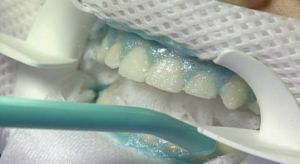 When choosing the bleaching method, the important role is played by the degree of enamel darkening and its thickness, as well as the degree of mineralization.
When choosing the bleaching method, the important role is played by the degree of enamel darkening and its thickness, as well as the degree of mineralization.
For lightening the enamel slightly or with its poor mineralization, it is suitable for LED, laser or halogen bleaching. LED and laser exposure are considered the most sparing.
For teeth with strong pigmentation and large thickness of enamel, bleaching of enamel with ultraviolet is suitable, which allows obtaining the most pronounced and quick effect.
To evaluate the effectiveness, as well as compare the results after applying all the methods that are used for photo-whitening your teeth, our photo gallery of patients before and after the procedure, as well as their feedback, will help.
About 3 months ago I decided that it's time to say goodbye to my yellow teeth- ugly, especially for the girl. After reading about the various methods of bleaching, it was decided on the light.
After I arrived at the clinic, the doctor told me about how the procedure will be carried out, what restrictions should be in the diet, what consequences may occur. But I was determined.
The doctor recommended laser bleaching, saying that my enamel is not very strong, and the laser is the safest method.
After the procedure I compared the color of the enamel with the photo "TO", and was pleasantly surprised - my teeth became much whiter! A few days after bleaching, it hurt a little bit from the cold, but I followed the recommendations - I used paste for sensitive teeth, avoided coloring products. And thanks to this I still enjoy the effect of this procedure. I am very pleased, because now I am confident in myself 100%.
Nina, 29
Agreed for teeth whitening with ultraviolet. The teeth became, of course, not porcelain-white, but light, just like they wanted. The first days the pain from the cold was strong, I had to see a doctor, so she covered her teeth with fluorine.
After this problem almost does not arise. Now 4 months have passed. Teeth slightly darkened, but this is due to the fact that I do not strictly adhere to the diet. And so - super, for an important event, and even please yourself - the very thing!
Lena, 31
Clarified teeth two days ago. I have thick enamel, but yellow. Immediately I asked the doctor to cover the enamel with varnish after the procedure. I can say that although my teeth sometimes hurt, nothing as terrible as some write, I do not. The enamel has become whiter, though not quite white.
I'm now following a diet, I do not eat or drink coloring products, I brush my teeth with fluoride paste. Sometimes a little whine, if you eat ice cream, but this can be tolerated. Or do not eat ice cream. .. But positive is the sea! I do not understand why I did not do this before?
Karina, 27
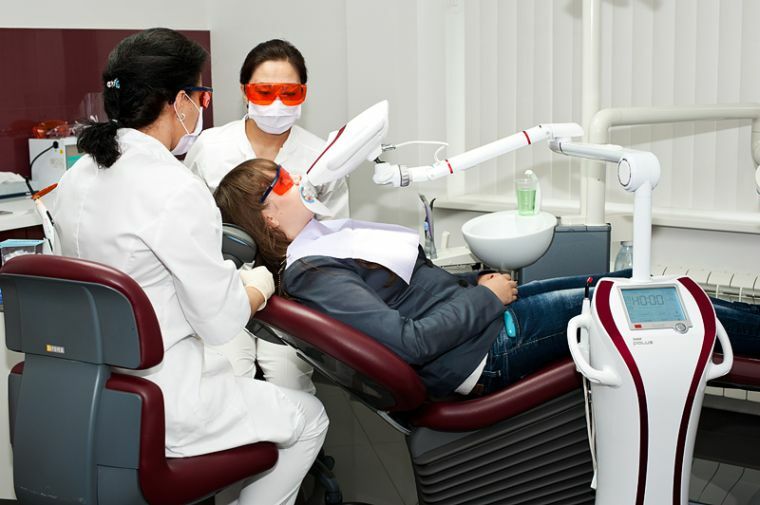
Not suitable for all
Contraindications to the use of any of the above methods of bleaching:
- mental disorders and obschemic diseases during decompensation;
- state of severe immunosuppression;
- of the TMJ;
- exacerbation of chronic AEDD diseases or acute mucosal diseases( aphthous and herpetic stomatitis, fungal infection, manifestations of venereal infections, periodontitis);
- low resistance or thin enamel;
- multiple caries;
- microcracks on the dental surface;
- pulpitis and periodontitis - preliminary sanitation of the oral cavity is required.
Consequences and complications of
Among the possible consequences:
- Hyperesthesia occurs as a result of the action of an oxidizing gel on demineralized enamel, - is a normal state after bleaching. It is manifested by the pain of using cold, hot, sweet and sour, which passes right after the elimination of the stimulus. To avoid hyperesthesia, it is recommended to cover the teeth with fluorolac after the procedure, as well as the use of pastes for sensitive teeth.
- Thermal burn of pulp occurs when a violation of the technology of bleaching or the use of unsuitable lamps. Characterized by severe pain, which is worse at night and does not pass by itself. This complication is not a normal condition and requires immediate treatment to the dentist.
- Thermal burn of mucous - is manifested by erosions, accompanied by pain and burning soft tissues of the oral cavity. In this case, the epithelium can peel off in the form of a white flap, exposing painful erosion. Such a condition requires treatment and does not arise if everything was done correctly.
Price
Depending on the equipment used, the price for fotobelivanie ranges from 6-8 to 25 thousand rubles.

